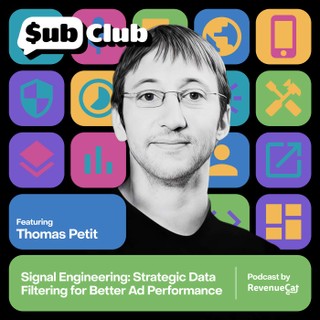
Signal Engineering: Strategic Data Filtering for Better Ad Performance — Thomas Petit, Independent Consultant
Sub Club by RevenueCat
The Evolution of AI in Ad Creativity
This chapter explores the impact of AI on advertising, focusing on its role in creative generation and the challenges it faces in analysis and ideation. The discussion highlights the balance between leveraging successful concepts and the need for continuous innovation in a rapidly changing digital landscape.
On the podcast I talk with Thomas about using signal engineering to optimize ad spend, how AI is changing creative testing, and why most people should avoid app2web… for now.
Top Takeaways:
🧠 The biggest AI opportunity in ads is smarter analysis, not faster production
AI is now good enough to produce ad-quality video and variants at scale — but that’s where 95% of the industry focus stops. The underused frontier is AI for analysis: spotting winning hooks, predicting performance, and even pre-testing creatives with “AI humans” before spend. The teams that combine rapid AI production with AI-driven analysis can iterate faster and scale what works more reliably.
🔍 Signal engineering starts with fixing broken data
If the events you send to ad networks are inaccurate or poorly mapped, you’re sabotaging the algorithms. First step: make sure event counts match internal analytics within ~5–10% (not 30–50%). Then move from “normal” to “sophisticated” by filtering for quality — for example, optimizing to high-LTV trial signups instead of all trials — and sending value-adjusted revenue that reflects predicted LTV, not just day-one spend.
⚖️ Balance exploitation of winners with exploration of new concepts
When a creative crushes it, it’s tempting to flood your account with variations. But over-reliance on a single concept speeds fatigue and leaves you exposed when performance drops. Keep iterating on winners and testing new hooks in parallel — especially on fast-moving platforms like TikTok, where trends expire in weeks.
🌐 App-to-web works best for big brands with deep resources
Moving checkout to the web can bypass app store fees, but it’s a high-commitment experiment. Success usually requires brand trust, team bandwidth, and a well-tested flow — often with different plan structures than in-app. For most smaller teams, the opportunity cost outweighs the benefit. “Saying no to good ideas” is often the smarter prioritization.
💳 Hybrid monetization is powerful, but not plug-and-play
Combining subscriptions with one-time or usage-based purchases can capture more revenue from different segments — especially for AI-powered apps with real compute costs. But designing it to avoid cannibalizing subscriptions is complex. Treat hybrid as a later-stage lever: exhaust easier wins in pricing, packaging, and paywall optimization first, then experiment, possibly starting with Android or non-US markets.
About Thomas Petit:
👨💻 Independent app growth consultant helping subscription apps like Lingokids, Deezer, and Mojo.
📈 Thomas is passionate about helping subscription apps optimize their ad spend and increase ROI through smarter testing.
💡 “The whole idea of signal engineering and optimization of the data that you're sending back is: send the network something better, and they're gonna do a better job. They are doing a better job — it's you who are not doing yours.”
Follow us on X:
- David Barnard - @drbarnard
- Jacob Eiting - @jeiting
- RevenueCat - @RevenueCat
- SubClub - @SubClubHQ
Episode Highlights:
[1:21] Testing smarter: How AI may be changing the game for testing ads.
[13:09] Untangling the web: App-to-web can work for some, but it’s not a slam dunk.
[21:19] Hedge your bets: The benefits of moving away from subscription-only and embracing hybrid monetization strategies.
[26:50] Going global: When and why to consider experimenting with hybrid monetization outside the US.
[31:15] Signal vs. noise: The signal engineering framework for sending the most valuable user interaction data to ad platforms.
[44:47] Multi-platform: Optimizing your data and event mapping for multiple ad networks.
[53:01] Low-hanging fruit: Scoring easy wins with signal engineering.
[1:08:04] Hands-off: Why ad networks likely won’t (and maybe shouldn’t?) implement built-in signal engineering tools for app marketers.
[1:14:05] Going deep: Advanced signal engineering techniques.
[1:26:09] Volume vs. quality: Why sending fewer events to ad networks may actually yield better results.


